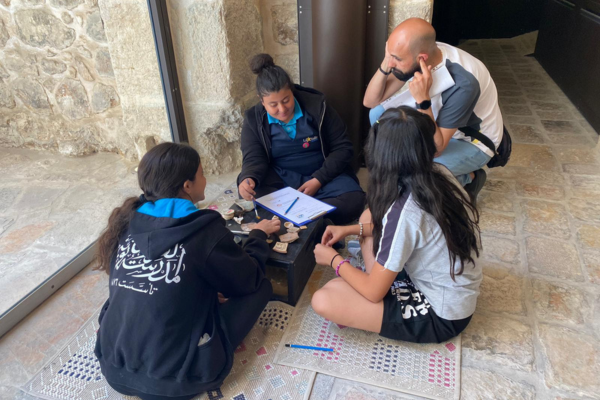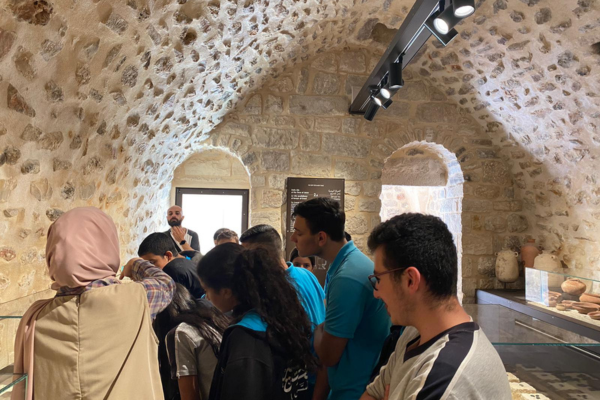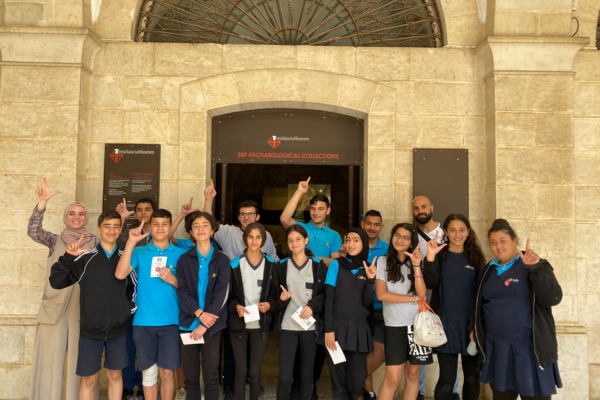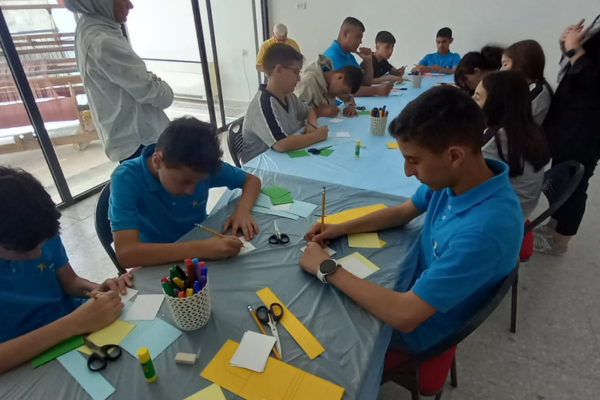Sara Cibin, art historian and expert museologist, coordinates the educational section of the Terra Sancta Museum. We asked her to tell us about this rib born within one of the most important projects in Jerusalem.
Sara, tell us about this new project: what is it, where does it come from and why?
The project is officially titled Community Living Museum for Palestinian Youth . It was born as a project funded by the European Community in the institutional program from the experience made in previous years at the Terra Sancta Museum in collaboration with the Mosaic Center of Jericho that has supported us in a series of small projects for local schools. With them we initially organized only simple thematic tours of the old town, which included the museum in its very early stages of development. Slowly the museum has grown and so has this experience.
It is a three-and-a-half-year project that began in 2020, not a particularly propitious year, but we also had a lot of preparatory work to do, and the first months of the project were actually used to create the staff that did not exist and set up a working group that had the necessary skills. We also had the time necessary to better set up all the work of the activities at the museum.


Why is this activity so important?
Because the children who live in East Jerusalem have a rather poor school and very often family situation. They do not have great opportunities because they are not offered either by the school system or by other situations that they may have in the family or outside. For this reason, it seemed absolutely necessary that the museum present these young people with an opportunity for recreation, but also for cultural growth.
What are the activities of the project and to whom do they refer?
The activities are different depending on the age in which children and young people are divided: some are addressed to children aged 5 to 8 years and activities that are addressed to children already a little older 9 to 11 or 12 years. Then there are some activities that we have designed for big high school kids and we have also done activities together with university students. Lately we have also come to involve mothers in some of the proposed activities.
All our activities are in Arabic, but we have also done some interesting experiments successfully, doing activities in English for Arabic children. Since they study English at school we have created the opportunity for children to be able to use a foreign language.
The activities are of different degrees according to age, some involve a very simple interaction such as drawing and knowledge of space; They are activities of interaction of the child with his context that can be through drawings or through physical activities of different kinds. They help children feel at home inside the museum, that is, they introduce them to the space so that they do not feel alien to it. It helps a lot the whole process of knowledge that arises from a moment of familiarity.
We then created Archeological Boxes produced by a carpentry school in East Jerusalem., which contain sand or different earth materials, but mainly the types of sand within which archaeological finds have been placed - obviously these are copies or symbolic objects that serve as archaeological finds - and through these boxes we let children experience archaeology. The museum presents archaeological objects and therefore in this way we open a window on the world of Archaeology and this again to do and therefore to be in a situation in which they feel involved. This also gives rise to curiosity about archaeology and the objects behind the windows. In addition, this way they can understand how they were found.
Another very important aspect of the activities is the collaboration with other museums in East Jerusalem, such as the Al Aqsa Mosque Museum or the Museum of Palestinian Culture. We have very similar objects. For example, we identified common iconographic motifs on the finds of the various museums and then we carried out activities in which these motifs were reused in a creative printing laboratory where we went to produce stamps that are used with ink for fabrics for clothing or fabrics that are brought by the participants to do recycling activities, Or again, we have created patterns on paper to cut out to create decorations and other elements of this type.
Adults also participated in fabric printing activities. In May, for example, we involved some ladies, mothers of families, who rarely have opportunities for recreation or relaxation from family life, but also to discover some historical and creative aspect of the museum, which characterizes this project.


The project has the characteristic of creating places of meeting and culture, creating bridges through the discovery of a common heritage. What impact does it have on the local community?
Surely there is a very significant aspect of encounter and it is given by the fact that the museum belongs to a Catholic Christian religious institution in a context where 90% if not more of the population is Muslim. Certainly the difference, that is, the differences, exist even if the Palestinian social fabric is quite cohesive, but it is true that there is a sort of passive indifference in the relations between one culture and another; So our attempt is precisely to undermine this kind of passivity. Hence the idea of collaborating with the Al Aqsa museum, for example, to find common points between a Christian entity, our museum, and a Muslim reality. And indeed we found common objects, decorations, some iconography etc. But the thing that really interested us was to bring out first of all that there is a mutual interest in knowing each other and exchanging precisely these aspects of the relationship of mutual knowledge. The points in common exist, but we must look for them and highlight them here. The primary value is therefore precisely the openness to this search for common points.
Is there a particular episode where you saw this possibility?
At first we invited various schools to visit the museum and one of the first schools we managed to involve was a Muslim school on the Mount of Olives that had brought visiting classes. A few days after visiting one of these classes, we found girls of about fourteen or fifteen years old in front of the entrance of the museum asking to visit it. The reception girl was a bit surprised at first, because such a thing had never happened and she was also a moment in difficulty in front of this scene. He couldn't believe it and initially thought it was a joke. But one of them immediately explained: "I took my friends to see the museum because they are not from the same school as me and they did not come with me last time, but I want them to see it because it is beautiful". This was really an important sign for me because I never imagined that a girl from the old Muslim city would be so impressed by that museum that she wanted to take her friends there at a time when they were out and about their business. This fact has greatly encouraged us, because for the first time in a place where usually only pilgrims pass [il Convento della Flagellazione di Gesù n.d.r] Muslim girls came and chose to devote their time to visiting a museum. They chose to spend their free time doing something they would never do and none of their peers do.


















